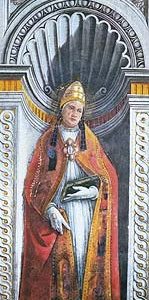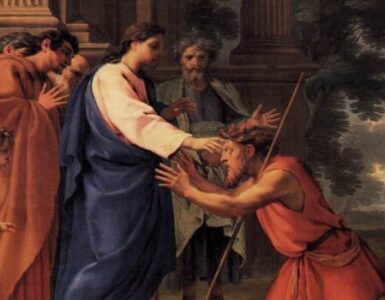Imagine living in world in which simply being a Catholic priest was a capital offense; imagine, too, that in this world, any person who hosted a priest in one’s home or hid a priest from the authorities was guilty of a capital offense. That was the world in which St. Anne Line lived. But what is so amazing in the case of Anne Line is that it was a world into which she knowingly entered. Anne chose to become Catholic at a time when practicing the Catholic faith in England was illegal and punishable even by death.
At her birth, she was given the name Alice by her Protestant parents. Her father was a leading Puritan, and her grandfather helped King Henry VIII in “reforming” the Church in England. When Alice announced to her family, sometime in the 1580’s, that she, her brother William, and her husband Roger were entering into the Catholic Church, they were summarily disinherited from the family.
At her reception into the Church, Alice took the name Anne, in honor of the mother of the Mother of God. From that point on, she was known as Anne.
Her disinheritance soon became a real issue since her husband, Roger, and her brother were arrested for attending Holy Mass; her brother was eventually released, but Roger was exiled from England. For a short time, Anne received some monetary support from her exiled husband, but this ended when he died. Anne was on her own all because she became Catholic.
As a devout Catholic, Anne’s life revolved around attending the Holy Sacrifice of the Mass, even if it could only be celebrated clandestinely and sporadically. She discerned a call, with the help of the Jesuit Father John Gerard, to help the priests who were risking their lives in order to celebrate the Holy Mass and to bring the faithful the Holy Eucharist. She conducted “safe houses” for the celebration of Mass and for priests to hide to elude discovery and capture—a fate that meant certain death.
The authorities had Father Gerard under surveillance, and his familiar association with Anne Line caused her too to become a person of interest. On the Feast of the Presentation of the Lord in the Temple, also known as Candlemas (since candles are blessed in the Mass), February 2, 1601, a large number of the Catholic faithful arrived at her home to participate in the secret Mass. The sheer number of people arriving at this house was enough to arouse suspicion, and the authorities were alerted that an illegal Mass might be underway.
The authorities responded quickly, but Anne was prepared. The priest, Father Francis Page, was able to remove his vestments and blend in among the laity. With the chaos that ensued in searching the house, most everyone was able to escape, including Father Page. (Father Page, however, would be discovered about a year later and was martyred for being a priest on April 20, 1602; he was beatified on December 15, 1929, by Pope Pius XI.)
The authorities did discover the altar and arrested Anne Line for suspicion that she had hidden, or was hiding, a priest. She was imprisoned in Newgate Prison until her trial on February 26, 1601. Without evidence that she had, in fact, hidden a priest, Anne was found guilty and sentenced to death by hanging, a sentence to be carried out the next day.
After her sentence was announced, Anne chose to discharge her conscience. She admitted to helping priests, and her only regret was that she could not have helped more than she did.
Before her execution was carried out, Anne repeated her statement at her trial: “I am sentenced to die for harboring a Catholic priest, and so far I am from repenting for having so done, that I wish, with all my soul, that where I have entertained one, I could have entertained a thousand!” (Stephanie Mann, 2017, “Candlemas and Four English Martyrs”). What holy boldness!
On February 27, 1601, Anne was hanged in the presence of two priests who were themselves to be hanged, drawn, and quartered: Father Mark Barkworth, OSB, and Father Roger Filcock, SJ, who was also Anne’s confessor.
After Anne died, and before she was removed from the scaffold, Father Filcock kissed the hem of her dress and declared: “Oh blessed Mrs. Line, who has now happily received thy reward, thou art gone before us, but we shall quickly follow thee to bliss, if it please the Almighty” (Stephanie Mann, 2017, “Candlemas and Four English Martyrs”).
She was canonized by Pope St. Paul VI on October 25, 1970, as one of the Forty Martyrs of England and Wales.
Father Mark Barkworth was beatified by Pope Pius XI on December 15, 1929, and Father Roger Filcock was beatified November 22, 1987, by Pope Saint St. John Paul II.
Reflection
St. Anne Line’s witness to the supreme importance of the Most Holy Eucharist, as revealed in her protection of priests, is particularly instructive in a time when, according to a recent Pew Research survey, faith in the Real Presence among self-identifying Catholics is at a historic low. If the Eucharist is not what the Church says it is, the real and substantial Body and Blood of Jesus, then St. Anne Line died a fool’s death. She died for wishful thinking. But if the Eucharist is, as Jesus Himself declared in the Gospel, His actual Body and Blood, then how can anything in life surpass its importance? Her death magnifies the reality of the Holy Eucharist and Its supreme importance in her life, in the life of the Church, and indeed in the life of the world.
For St. Anne Line, to protect the priests, who are the very means by which the Eucharist is made present, was her way of ensuring the perpetuation of the Eucharist since it is impossible to have that Sacrament apart from priests. Do we regularly pray for our priests? Do we beseech God to keep priests pure and holy? Do we pray for an increase in vocations to the sacred priesthood?
Let us ask for the intercession of St. Anne Line as we grow in devotion to the Eucharist, in self-sacrifice, and in prayer for our spiritual fathers!
Editor’s Note: This article is adapted from a chapter in Rev. J. Francis Sofie’s book Martyrs of the Eucharist: Stories to Inspire Eucharistic Amazement, available from Tan Books.
Photo by Alireza Jalilian on Unsplash










